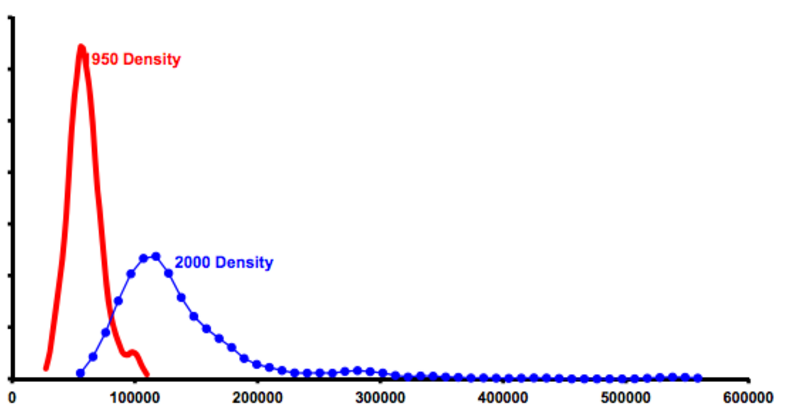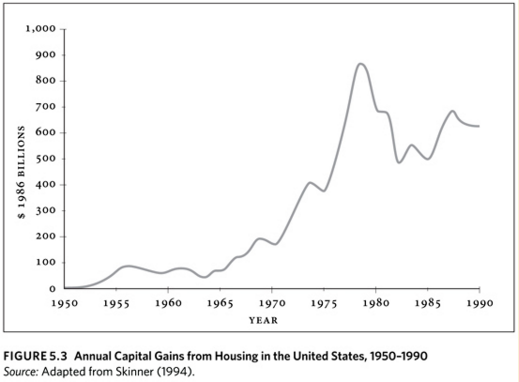Yesterday, we published a “zoning parable,” based on William Fischel’s arguments for why and how zoning regulations developed in American cities over the 20th century. Today, we’ll expand a bit on one of the book’s major arguments in non-parable form.
The 70s: What happened?
For people who care a lot about housing but aren’t ready to read 430 pages about zoning, perhaps one of the most interesting and important arguments in the book is that our current crisis of high housing prices has its roots in the land use revolution of the 1970s.
Prior to that decade, Fischel writes, zoning had certainly been effective in creating exclusionary communities—since the 1920s, many critics (and some proponents) had argued that that was the whole point. It did so by creating legal districts where only high-cost housing could be built. But these exclusionary communities existed at the scale of the neighborhood or the suburb: other municipalities in the same metropolitan area acted as a kind of housing development safety valve, accepting higher-density development and keeping the regional housing market more or less in balance.
But in the decades after World War Two, something changed. Suburbs that had been pro-growth amended their zoning laws to shut the door on higher-density housing—and sometimes any housing at all. As a result, exclusionary zoning was transformed from something that constrained development in individual communities to something that could operate on the level of an entire metropolitan area.
The results have completely changed the economic geography of American cities. Before the zoning revolution of the 70s, the highest-cost metropolitan areas had home prices that were about twice the national average; by 2000, that gap had doubled to four times greater than the national average. The chart below shows this dramatic change in another way. It compares the number of metropolitan areas (along the y axis) by their median home price (along the x axis). In 1950, there wasn’t a ton of variation: some places were more expensive than others, but the gaps were relatively small. By 2000, there were many fewer “normal” metro areas around the peak, and a very long tail, representing the extremely high housing prices in elite regions.

As a result, migration to these high-cost, high-productivity regions has slowed significantly. All of a sudden, one of the major ways that low-income people had improved their economic status—moving to a place with more and better-paying jobs—became impractical in the face of steeply rising home prices. For many years, high-income states had seen the country’s highest levels of in-migration; but in this period, that pattern came to an end, as the high cost of living more than offset higher incomes for many people.
As these high-cost metro areas became more and more exclusionary, the gaps in average income between regions, which had been declining for a century, suddenly reversed course. In 1940, median income in Connecticut had been 4.37 times greater than that of Mississippi; by 1980, that figure had declined to 1.76. But in the next thirty years, it ticked back up to 1.77. The end of regional income convergence appears to have played a significant role in rising levels of national income inequality, which began to increase at around the same time.
Zoning Rules! is not the first or only place this story has been told. Fischel’s novel contribution is in trying to explain why this change took place. He identifies several major factors, including:
- The construction of the interstate highway system allowed industrial and commercial development to move into the suburbs. In addition to threatening the residential character of the suburbs, this development meant that lower-income people, who may previously have wanted to stay close to central cities for better access to jobs, had reason to move out to suburbs in pursuit of decentralized employment centers. Many suburbs reacted by increasing restrictions on new housing.
- The challenge to “exclusionary zoning” as part of the Civil Rights Movement. In the 1970s, a series of lawsuits challenged suburban zoning that favored single-family home districts on grounds of discrimination, and some of them, including the Mt. Laurel case, appeared to have a credible chance of overturning existing regulations. In response, Fischel argues, many suburbs adopted the “seemingly neutral policy of restricting all development, not just that for low-income people.
- The granting of legal standing to opponents of development. Laws like the National Environmental Policy Act gave neighbors the ability to sue to stop developments on environmental grounds, which were more sympathetic than previous arguments based on property values or “community character.” (More sympathetic and also, Fischel admits, sometimes actually legitimate.) Previously, “neighbor suits” against development had generally failed; they became much more successful starting in the 1970s.
- The creation of multiple veto points. In the 1970s, metropolitan areas began to create regional governments with some planning power. But rather than giving them the ability to overrule local regulation, the new bodies created a “double veto” system in which an objection at the local or regional level could derail a development project.
- The rapid growth of home values as a part of homeowner wealth. Between the 1960s and 1979, housing increased from 21 percent of net household wealth to 30 percent. Rising inflation and the mortgage interest tax deduction combined to make housing a much more attractive investment than more heavily taxed capital gains, like stocks. This made homeowners much more sensitive to development that might affect their property values.

Of these, Fischel puts by far the most weight on the last. One of the major themes of the book is that zoning, which is often portrayed as a technocratic, top-down set of regulations spearheaded by professional planners, is actually driven by grassroots—more specifically, homeowners’—demands to protect their home values. (Though that explanation isn’t uncontested—scholars like Sonia Hirt, for example, privilege arguments about the cultural appeal of single family homes in America.) Over and over, “elite” efforts to enact zoning changes against the wishes of these voters have been defeated. Notably, this is true both for efforts to make zoning more severe, as in the campaign to demolish “nonconforming” homes; and to loosen it, as in the case of court-driven attempts to break exclusionary zoning.
So increasing the incentives for these “homevoters” (to use Fischel’s term) to clamp down on new construction is hugely important—and, crucially, self-reinforcing, as successfully protecting property values makes homes an even larger part of homeowners’ financial portfolios, so people are even more sensitive to their price fluctuations, and so on. It also means that efforts to reform zoning laws to reduce their exclusionary effects (and their role in promoting sprawl by limiting density) need to address this demand for zoning.
Monday, in our last post on Zoning Rules!, we’ll talk about what Fischel proposes to do about that.
